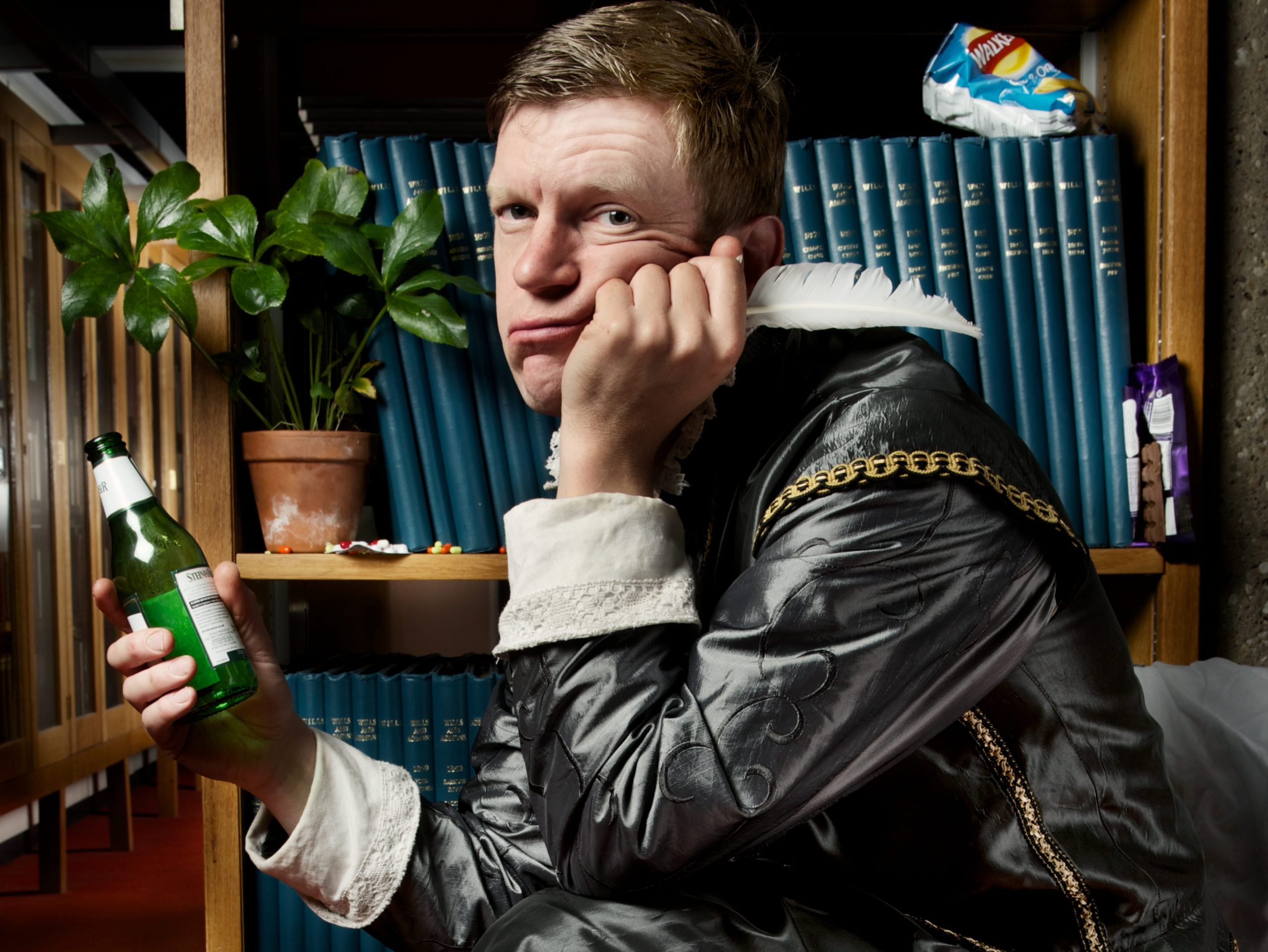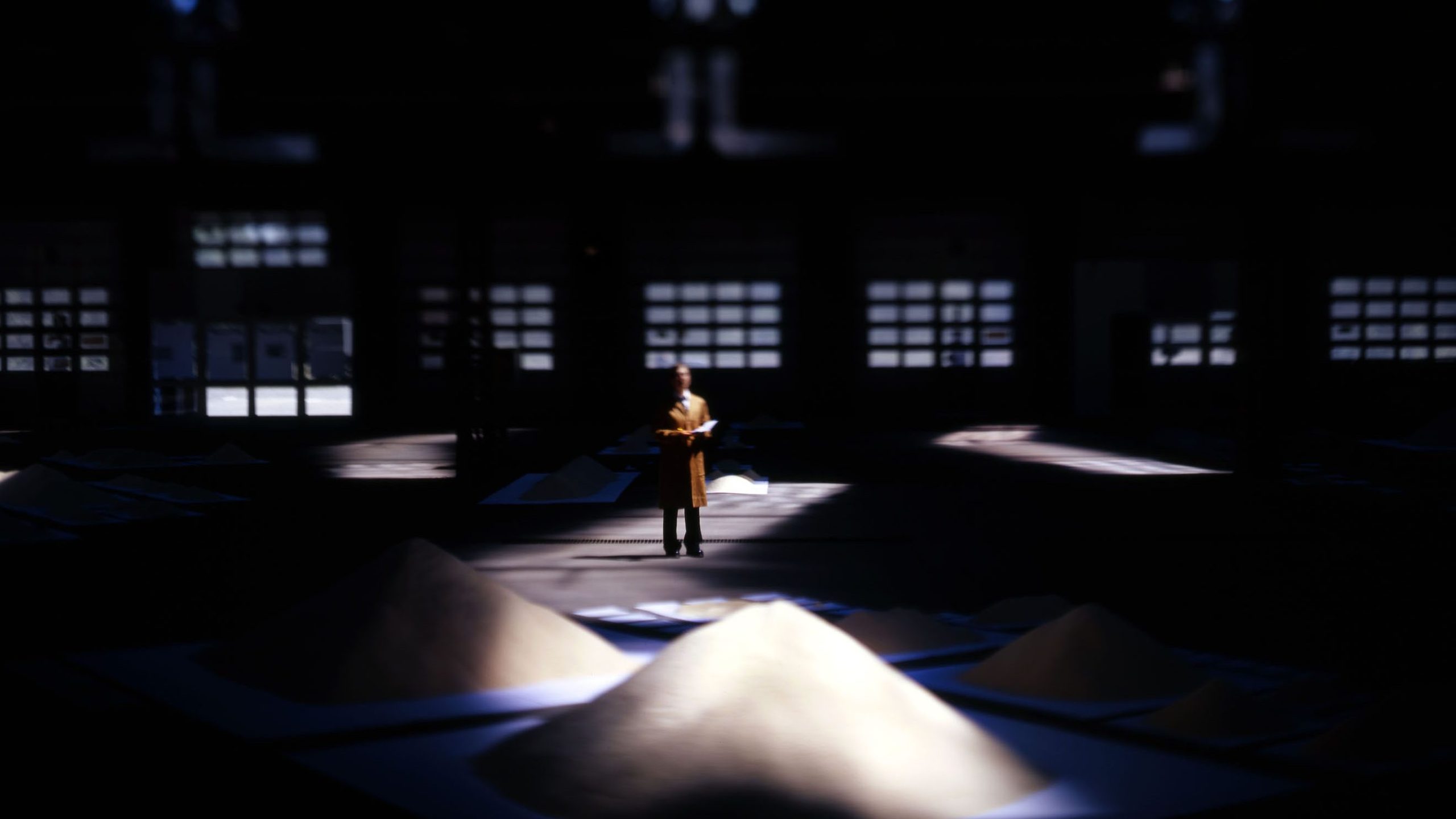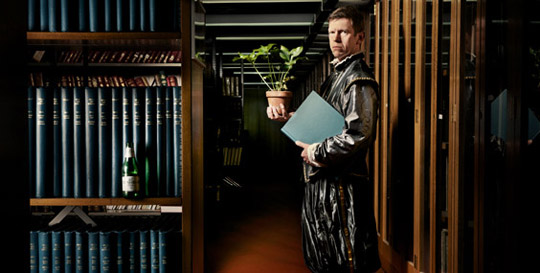
The Original Idea.
We were in Belgrade in 2002 when Nenad Prokic, who had booked us to perform our show It’s Your Film there, said Stan’s Cafe was the only company he could imagine adapting his favourite book for the stage.
The book was The Anatomy of Melancholy. We have never adapted a text for the stage before because it’s not something that has ever interested us, normally because the books that get adapted are novels and we’re not that interested in telling stories. The Anatomy of Melancholy is not a story, its challenge is more like adapting a 1500 page long, 400 year old encyclopaedia for the stage. This is the kind of ludicrous project that does interest us. After nearly a decade the content started to interest us too, more people we knew were being prescribed anti-depressants, so the idea of melancholy felt current.
The Approach.
It is rare for us to start a project without any idea how the staging would work, usually ideas for form and content evolve together, here most of the content was a given. It took us a while to work out our approach.
We knew the project was about staging the book and we were interested in what it meant to adapt a book, we knew we wanted the book to be very present on stage. An obviously approach would be to have someone play Burton and give an illustrated talk, but this approach would be limiting. We committed to a larger cast and found that the nature of the text – a collage of sources, voices and conflicting opinions – leant itself to having numerous voices on stage.
Stage Design.
Burton’s The Anatomy of Melancholy has an intricate structure, which he maps out at the start of the book. We decided to share this structure with the audience as a feature of the stage design in order help orientate the audience in the work and the developing argument. This design idea also helps indicate the amount of material that is being cut out in our adaptation.
Editing.
A large proportion of the process of adapting The Anatomy of Melancholy was editing the text. This was done collectively in the rehearsals room. The process, which evolved through the course of rehearsals, mostly involved me bringing a proposed edit to cast. This initial edit principally comprised elements I thought most theatrical, most arresting, with the most contemporary relevance or the most moving. Others helped make the through line of argument more coherent and suggested excellent or important elements I had missed.
From this first edit we started a process of ever more ruthless cutting. Part of the challenge was that the original book is renowned for being absolutely vast, full of huge lists, repetition, vast numbers of examples, qualifications and many digressions, we wanted to retain the essence of the book without our show being absurdly long or ‘too much’. We were happy for our audience to have to work hard, concentrating and thinking for a long stretch, but we also need to give them some chance.
We cut sub-sections, we cut digressions, we cut examples, we slim arguments down, we chop lists down to size and nip words out from within sentences. Our aim, like new music technology was to shorten the show’s duration without shifting its pitch.
The edits we have made are sometimes marked within the performance. A passing line in the conclusion mentions Religious Melancholy which forms the final section of the book but which does not appear in our show. Following audience feedback we between premiere performances at Warwick Arts Centre in early 2013 and touring that Autumn we cut the script back further, cutting right back on herbal cures that carry little contemporary resonance and snipping out some elements that may be seen as repetitions. Every clause of every sentence has had to fight for its place in the most recent version of the show.
Burton Scholars have described our edit is a contraction of the original, which suits us well.
Script in Hand.
In looking for an approach to the text we read that Burton had written two unsuccessful plays prior to his enormously successful book. We allowed ourselves to imagine that Burton may still fancy himself as a playwright and may see his ‘best selling’ book as an opportunity to have a hit show. Maybe this adaptation should not be ours, but Burton’s. He continued to revise his text until the end of his life, there is a precedent for the text to be fluid. I’d initially thought that Burton’s veneration of the Ancient Greeks should be reflected in his theatrical approach – but this turned out not to be a very helpful idea.
Our previous theatre show The Cardinals was based on a show within a show. I didn’t want to return to exactly this territory. I was more interested in staging what may be a late rehearsal – hence scripts are in hand – as this would give us a greater flexibility. This ‘meta fiction’ was discussed a fair bit in rehearsals, there was a concern about if this was a rehearsal then are the audience not really there? There were similar arguments around Voodoo City that were never satisfactorily resolved. In Home of the Wriggler we had discussions in this area but sorted them out. For The Anatomy of Melancholy the presence of the audience and opportunity for direct address seem very important. So ultimately it probably is a performance not a rehearsal, but thinking about it as a rehearsal for a while allowed us to include some elements that we like (scripts in hand, annotating scripts, late additions, forgotten edits) that wouldn’t otherwise have got in.
‘Characters’
It is rare for there to be conventionally defined ‘characters’ in Stan’s Cafe shows. In The Anatomy of Melancholy there is a logic behind who says what but this doesn’t emerge from an idea of character, if character exists it is the sum total of everything that figure says (and of course the way the actor delivers these lines). The figures on stage are used to illustrate the four elements (a theme picked up in the colour of the costumes), different forms of melancholy or aspects of the spirit then stop short of personifying them.
In a similar way the ‘dramatic’ scenarios illustrate their point rather than committing fully to their drama.
Latin and Citations
I was keen to stay true to the text by including the Latin and referencing sources. Originally I had thought this would be done via an anachronistic red LED display sign operated on stage by a disgruntled man servant stage manager but this idea started to feel inflexible, logistically difficult and visually compromising, it felt that it should be a paper based show.
Anachronisms.
We had originally thought we may sneak some anachronisms into the text in order to point up parallels between what Burton is talking about and contemporary ideas and experiences, but on reading the text we found the parallels to be so obvious that audiences wouldn’t need this help. In fact, we realised any fiddling with the text from us would lead people to assume that some things that are in the original text are written by us. So we restricted ourselves to only putting anachronisms into the show’s visuals.
Script Fiddling.
Having said we didn’t fiddle with the text (beyond cutting it) this isn’t entirely true. Occasionally the transposition from text to stage felt it needed acknowledging by changing ‘reader’ to ‘audience’ or ‘book’ to ‘theatrical production’. Also occasionally ‘I’ is changed to ‘We’. Some times these alternations are pointed up within the performance.
Casting.
Though Burton’s world at Christchurch College would have been dominated by men we knew we didn’t want our show to be male only. In our production The Just Price of Flowers women play male characters, with drawn on moustaches we discussed this but decided we preferred to leave things more open. Of course Shakespeare was a relatively close contemporary of Burton and in his plays young men would have played the female roles and these female characters themselves sometimes disguised themselves as men, we thought we’d allow ourselves a similar kind of fun.
Why are we doing this?
I normally have a very good idea why we are making one of our shows, not just why we are making it but why we are making as a piece of theatre. For this show the answer to this vital question wasn’t immediately clear. Doing it to answer a challenge isn’t a good enough answer – it’s too close to doing it for a dare. Making a show to talk about depression and melancholy was closer as was a reflection on history and adaptation, but it took a long time before I found my answer (others may have theirs). In Mary Ann Lund’s book, Melancholy, Medicine and Religion in Early Modern England: Reading ‘The Anatomy of Melancholy’, she describes The Anatomy of Melancholy as not just a description of cures for melancholy but a cure in itself – that the act of reading the book would be enough in itself to act as a temporary cure. Why shouldn’t our show be a cure for melancholy? This linked with some early thinking in which I had imagined that the show would reflect how theatre can be a site for exploring melancholy and relieving melancholy by having the book based elements of the show intercut with some wild dance up-lifting dance elements. That idea didn’t survive for long by Dr. Lund allowed me to think that the show didn’t need to separate the two theatrical masks, hopefully the show could be about a cure for melancholy whilst also being a cure for melancholy.
Reception.
We knew from the start that this would be an unusual show and that some people would find it a challenging experience. This is not a good reason not to do it, but there is no harm in trying to help audiences out – particularly students who may not have chosen to have come and see the show but have been forced to! As well as trying to make the performances engaging it felt useful to put some tips into the program, all three tips are to help people relax and feel comfortable in the show.
The first tip is about the language and encourages people that their ears will tune into the language, as it does when watching Shakespeare.
The second tip is that the show isn’t a story. It is usual for people to come to the theatre expecting and thus looking for a story, sometimes they are flummoxed and upset when they can’t find that story. It seemed sensible to give people a hint for how to watch the show.
The final tip is about concentration. Normally the measure of a show’s success can be if people are riveted to every word spoken, however if a show provokes questioning or memories or speculations then that is a success as well, but if you do those things during a show you are liable to miss some of what is being said on stage. Fortunately in this show this won’t be a problem – you won’t miss the vital clue, and we can tell you now, the butler did it!
James Yarker, 26th February 2014





